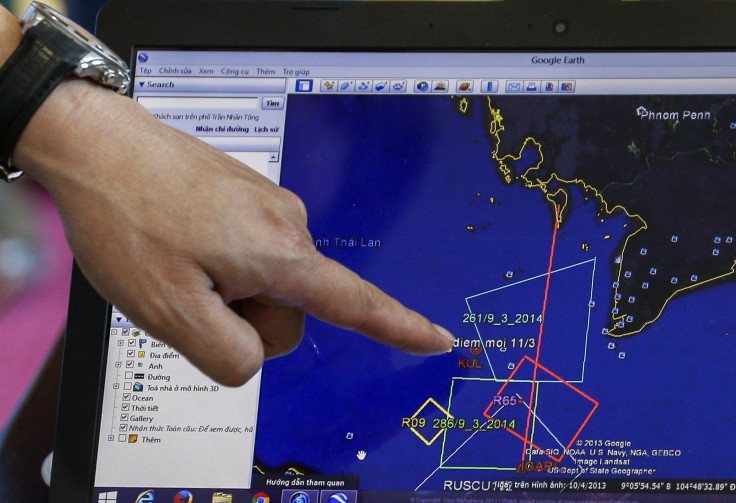Malaysia Says No Evidence Missing Plane Flew Hours After Losing Contact

(Reuters) - Malaysian authorities said on Thursday there was no evidence that a jetliner missing for almost six days flew for hours after losing contact with air traffic controllers and continued to transmit technical data.
The Wall Street Journal said that U.S. aviation investigators and national security officials believed the Boeing 777 flew for a total of five hours, based on data automatically downloaded and sent to the ground from its Rolls-Royce Trent engines as part of a standard monitoring program. (r.reuters.com/ruw57v)
"Those reports are inaccurate," Malaysian Transport Minister Hishammuddin Hussein told a news conference. "As far as both Rolls-Royce and Boeing are concerned, those reports are inaccurate. The last (data) transmission from the aircraft was at 01:07 a.m.(local time) which indicated that everything was normal."
Reuters has previously reported that the plane's transmission of the so-called ACARS technical data ceased after it lost contact with air traffic control.
Malaysia Airlines Flight MH370, with 239 people on board, dropped off air traffic control screens at about 1:30 a.m. on Saturday, less than an hour into a flight from Kuala Lumpur to Beijing. There were no reports of bad weather or mechanical problems.
It is one of the most baffling mysteries in the history of modern aviation - there has been no trace of the plane since nor any sign of wreckage despite a search by the navies and military aircraft of over a dozen countries across Southeast Asia.
The last definitive sighting on civilian radar screens came as the plane flew northeast across the mouth of the Gulf of Thailand.
On Wednesday, Malaysia's air force chief said military radar had traced what could have been the jetliner to an area south of the Thai holiday island of Phuket in the Malacca Strait, hundreds of miles to the west of its last known position. However, he stressed the plotting had not been corroborated.
The multi-national search team is combing both bodies of water, which total 27,000 square nautical miles (93,000 square km), an area the size of Hungary.
Hishammuddin however said the focus was on the Gulf of Thailand and the nearby South China Sea, where the plane lost contact. The United States will send the world's most advanced maritime surveillance aircraft, the P-8A Poseidon, to join the search later this week.
WRONG IMAGES
On the sixth day of the search, planes scanned an area of sea where Chinese satellite images had shown what could be debris, but found no sign of the airliner. Hishammuddin said the images were provided accidentally.
"The Chinese government neither authorized nor endorsed (putting it on a website)," he said. "The image is not confirmed to be connected to the plane."
It was the latest in a series of false signals for the Boeing 777-200ER, adding to the confusion and agony of the relatives of the passengers.
As frustration mounted over the failure to find any trace of the plane, China heaped pressure on Malaysia to improve coordination in the search. Around two-thirds of the people aboard the lost plane were Chinese.
Premier Li Keqiang, speaking at a news conference in Beijing, demanded that the "relevant party" step up coordination while China's civil aviation chief said he wanted a "smoother" flow of information from Malaysia, which has come under heavy criticism for its handling of the disaster.
If the military radar signal cited by air force chief Rodzali Daud was the missing plane, the aircraft would have flown for 45 minutes and dropped only about 5,000 feet in altitude since its sighting on civilian radar in the Gulf of Thailand.
That would mean the plane had turned sharply west from its original course, travelling hundreds of miles over the Malay Peninsula from the Gulf of Thailand to the Andaman Sea to a point roughly south of Phuket and east of the tip of Indonesia's Aceh province and India's Nicobar island chain.
Indonesia and Thailand have said their militaries detected no sign of any unusual aircraft in their airspace. Malaysia has asked India for help in tracing the aircraft and New Delhi's coastguard planes have joined the search.
U.S. EXPERTS ASSISTING
The U.S. National Transportation Safety Board said in a statement that its experts in air traffic control and radar who traveled to Kuala Lumpur over the weekend were giving the Malaysians technical help.
A U.S. official in Washington said the experts were shown two sets of radar records, military and civilian, and they both appeared to show the plane turning to the west across the Malay peninsula.
But the official stressed the records were raw data returns that were not definitive.
Authorities have not ruled out any cause for the disappearance. Malaysian police have said they were investigating whether any passengers or crew on the plane had personal or psychological problems that might shed light on the mystery, along with the possibility of a hijacking, sabotage or mechanical failure.
Hishammuddin however said media reports that police had searched the homes of the missing aircraft's crew were false.
Two of the passengers on board were discovered by investigators to have false passports, but they were apparently seeking to emigrate illegally to the West.
The Boeing 777 has one of the best safety records of any commercial aircraft in service. Its only previous fatal crash came on July 6 last year when Asiana Airlines Flight 214 struck a seawall with its undercarriage on landing in San Francisco, killing three people.
Boeing has declined to comment beyond a brief statement saying it was monitoring the situation.
(Additional reporting by Niluksi Koswanage, Siva Govindasamy, Yantoultra Ngui and Al Zaquan Amer Hamzah in Kuala Lumpur, Ben Blanchard in Beijing, Mai Nguyen, Ho Binh Minh and Martin Petty in Hanoi, Tim Hepher in Paris. Mark Hosenball in Washington; Writing by Raju Gopalakrishnan; Editing by Nick Macfie)
© Copyright IBTimes 2025. All rights reserved.
Join the Discussion





















